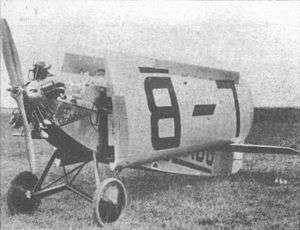Walter Vega
| Vega | |
|---|---|
 | |
| Walter Vega fitted to an Avia BH-11b at the "Challenge International de Tourisme 1929". | |
| Type | Radial aircraft engine |
| National origin | Czechoslovakia |
| Manufacturer | Walter Aircraft Engines |
| First run | 1929 |
The Walter Vega was a five-cylinder, air-cooled, radial engine for aircraft use, built in Czechoslovakia in the late 1920s.
Applications
Specifications
Data from Flight.[1]
General characteristics
- Type: five-cylinder radial engine
- Bore: 105 mm (4.1 in)
- Stroke: 120 mm (4.7 in)
- Dry weight: 102.5 kg (226 lb)
Components
- Valvetrain: Overhead valve, one inlet and one exhaust valve per cylinder
- Fuel system: Zenith Type 50J carburettor
- Fuel type: Petrol
- Oil system: Pressure and scavenge pump
- Cooling system: Air-cooled
- Reduction gear: Direct-drive
Performance
- Power output: 63 kW (85 hp) at 1,750 rpm
- Compression ratio: 5.15:1
- Power-to-weight ratio: 0.61 kW/kg (0.37 hp/lb)
See also
- Related lists
References
| Wikimedia Commons has media related to Walter Vega. |
- ↑ Flight - 25 July 1929, p. 762. Retrieved: 29 May 2012
- Gunston, Bill (1986). World Encyclopedia of Aero Engines. Wellingborough: Patrick Stephens. p. 168.
- Němeček, V. (1968). Československá letadla. Praha: Naše Vojsko.
- moraviation.com
This article is issued from
Wikipedia.
The text is licensed under Creative Commons - Attribution - Sharealike.
Additional terms may apply for the media files.